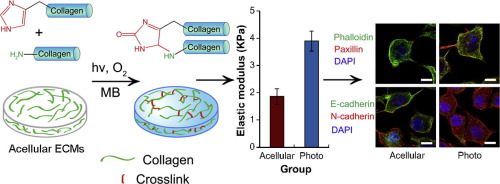Acta Biomaterialia ( IF 9.4 ) Pub Date : 2018-03-17 , DOI: 10.1016/j.actbio.2018.03.020 Wei-Dong Lü , Rui-Fang Sun , Ye-Rong Hu , Jan-Rong Lu , Lu Gu , Zhi-Gang Liu , Guang-Yan Lei , Zhun Qiang , Lin Cai

|
Acellular tumor extracellular matrices (ECMs) have limitations when employed as three-dimensional scaffolds for tumor engineering. In this work, methylene blue-mediated photooxidation was used to crosslink acellular tumor ECMs. Photooxidative crosslinking greatly increased the stiffness of acellular tumor ECM scaffolds but barely altered the Amide III band of the secondary structure of polypeptides and proteins. MCF-7, HepG2 and A549 cells cultured on photooxidatively crosslinked acellular tumor ECM scaffolds exhibited greater cell number per scaffold, more IL-8 and VEGF secretion, and increase migration and invasion abilities than cells cultured on uncrosslinked acellular tumor ECM scaffolds. The three tumor cell lines cultured on the stiffer photooxidatively crosslinked acellular matrices acquire mesenchymal properties (mesenchymal shift) and dedifferentiated phenotypes. Furthermore, the malignant phenotypes induced in vitro when cultured on the crosslinked scaffold promoted the in vivo tumor growth of BALB/c nude mice. Finally, the dedifferentiated cancer cells, including MCF-7, HepG2 and A549 cells, were less sensitive to chemotherapeutics. Thus, photooxidatively crosslinked acellular tumor ECMs have potentials as three-dimensional (3D) tumor engineering scaffolds for cancer research.
Statement of Significance
Natural material scaffolds have been successfully used as 3D matrices to study the in vitro tumor cell growth and mimic the in vivo tumor microenvironment. Acellular tumor extracellular matrices (ECMs) are developed as 3D scaffolds for tumor engineering but have limitations in terms of elastic modulus and cell spheroid formation. Here we use methylene blue-mediated photooxidation to crosslink acellular tumor ECMs and investigate the influence of photooxidative crosslinking on structural, mechanical and biological characteristics of acellular tumor ECM scaffolds. It is the first study to evaluate the feasibility of photooxidatively crosslinked acellular tumor ECMs as 3D scaffolds for cancer research and the results are encouraging. Moreover, this study provides new research areas in regard to photodynamic therapy (PDT) for Cancer.
中文翻译:

光氧化交联的无细胞肿瘤细胞外基质作为潜在的肿瘤工程支架
当用作肿瘤工程的三维支架时,无细胞肿瘤细胞外基质(ECM)具有局限性。在这项工作中,使用亚甲基蓝介导的光氧化作用来交联无细胞肿瘤ECM。光氧化交联极大地增加了无细胞肿瘤ECM支架的刚度,但几乎没有改变多肽和蛋白质二级结构的酰胺III谱带。与在未交联的无细胞肿瘤ECM支架上培养的细胞相比,在光氧化交联的无细胞肿瘤ECM支架上培养的MCF-7,HepG2和A549细胞显示出每个支架更大的细胞数,更多的IL-8和VEGF分泌,并增加了迁移和侵袭能力。在较硬的光氧化交联的无细胞基质上培养的三种肿瘤细胞系具有间充质特性(间质转移)和去分化表型。此外,恶性表型的诱导当体外培养在交联支架上时,促进了BALB / c裸鼠体内肿瘤的生长。最后,去分化的癌细胞,包括MCF-7,HepG2和A549细胞,对化学疗法的敏感性较低。因此,光氧化交联的无细胞肿瘤ECM具有作为癌症研究的三维(3D)肿瘤工程支架的潜力。
重要声明
天然材料支架已成功用作3D矩阵,以研究体外肿瘤细胞的生长并模拟体内肿瘤微环境。无细胞肿瘤细胞外基质(ECM)被开发为用于肿瘤工程的3D支架,但在弹性模量和细胞球体形成方面存在局限性。在这里,我们使用亚甲基蓝介导的光氧化作用来交联无细胞肿瘤ECM,并研究光氧化交联对无细胞肿瘤ECM支架的结构,机械和生物学特性的影响。这是第一项评估光氧化交联的无细胞肿瘤ECMs作为3D支架用于癌症研究的可行性的研究,其结果令人鼓舞。此外,这项研究为癌症的光动力疗法(PDT)提供了新的研究领域。











































 京公网安备 11010802027423号
京公网安备 11010802027423号